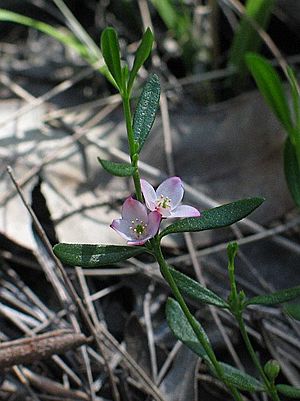Dwarf boronia facts for kids
Quick facts for kids Dwarf boronia |
|
|---|---|
 |
|
| Scientific classification | |
| Synonyms | |
|
The Dwarf Boronia (scientific name: Boronia polygalifolia) is a beautiful plant that belongs to the citrus family, called Rutaceae. You can find this special shrub growing only in eastern Australia. It's known for being a low-lying plant with simple leaves and pretty white or pink flowers. These flowers usually grow alone or in small groups of up to three, tucked into the spots where leaves meet the stem.
What Does Dwarf Boronia Look Like?
Dwarf Boronia is a small, spreading bush that usually grows to about 30 centimeters (about 1 foot) tall. Its branches also spread out about 30 centimeters. The whole plant is smooth, meaning it doesn't have hairs, except for its flowers.
Its leaves are simple and usually don't have a stalk (they are sessile). They are long and narrow, measuring about 6 to 30 millimeters long and 1 to 6 millimeters wide. The edges of the leaves are often curved downwards or rolled under.
The flowers usually grow alone, but sometimes in groups of up to three. They appear where the leaves meet the stem (called the axil). Each flower sits on a small stalk, or pedicel, which is about 1 to 11 millimeters long.
The flowers have four sepals, which are like small, leaf-like parts that protect the bud. These are egg-shaped to triangular, about 1.5 to 2 millimeters long and 1 to 1.5 millimeters wide, and are smooth. The four petals are either pink or white and are about 4.5 to 6.5 millimeters long. Their bases overlap each other. Inside the flower, there are eight stamens (the parts that produce pollen) that have hairy edges.
Dwarf Boronia mainly flowers from September to January. After flowering, it produces a smooth, dry fruit called a capsule, which is about 4 to 5 millimeters long.
How Did It Get Its Name?
The Dwarf Boronia was first officially described in 1798 by a scientist named James Edward Smith. He wrote about it in his book Tracts relating to natural history.
The second part of its scientific name, polygalifolia, helps us understand what it looks like. It means "with leaves like Polygala". This is because the leaves of the Dwarf Boronia look similar to the leaves of plants in the Polygala group.
Where Does Dwarf Boronia Grow?
Dwarf Boronia grows in open forests, woodlands, and heath areas. You can find it in different parts of eastern Australia. In Queensland, it grows between the Blackdown Tableland and Kroombit Tops. In New South Wales, it's found between Moruya and Geehi. There has also been one plant recorded in eastern Victoria.

